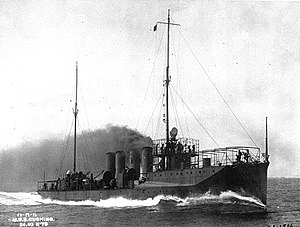USS Cushing (DD-55)

USS Cushing (DD-55), steaming at 24.93 knots during builder's trials, 25 May 1915. Note that her guns and torpedo tubes have not yet been installed.
|
|
| History | |
|---|---|
|
|
|
| Name: | Cushing |
| Namesake: | Commander William B. Cushing |
| Ordered: | March 1913 |
| Builder: | |
| Cost: | $891,626.54 (hull and machinery) |
| Yard number: | 215 |
| Laid down: | 23 September 1913 |
| Launched: | 15 January 1915 |
| Sponsored by: | Miss M. L. Cushing |
| Commissioned: | 14 August 1915 |
| Decommissioned: | 7 August 1920 |
| Renamed: | DD-55, 1 July 1933 |
| Struck: | 7 January 1936 |
| Identification: |
|
| Fate: | Sold on 30 June 1936 and scrapped |
| General characteristics | |
| Class and type: | O'Brien-class destroyer |
| Displacement: |
|
| Length: | 305 ft 3 in (93.04 m) |
| Beam: | 31 ft 1 in (9.47 m) |
| Draft: |
|
| Installed power: |
|
| Propulsion: |
|
| Speed: |
|
| Complement: | 5 officers 96 enlisted |
| Armament: |
|
USS Cushing (Destroyer No. 55/DD-55) was an O'Brien-class destroyer built for the United States Navy prior to the American entry into World War I. The ship was the second U.S. Navy vessel named in honor of William B. Cushing, a U.S. Navy officer best known for sinking the Confederate ironclad warship CSS Albemarle during the American Civil War.
Cushing was laid down by the Fore River Shipbuilding Company of Quincy, Massachusetts, in September 1913 and launched in January 1915. The ship was a little more than 305 feet (93 m) in length, just over 31 feet (9.4 m) abeam, and had a standard displacement of 1,050 long tons (1,070 t). She was armed with four 4-inch (102 mm) guns and had eight 21-inch (533 mm) torpedo tubes. Cushing was powered by a pair of steam turbines that propelled her at up to 29 knots (54 km/h).
After her August 1915 commissioning, Cushing sailed off the east coast and in the Caribbean. She was one of seventeen destroyers sent out to rescue survivors from five victims of German submarine U-53 off the Lightship Nantucket in October 1916. After the United States entered World War I in April 1917, Cushing was sent overseas to patrol the Irish Sea out of Queenstown, Ireland. Cushing made several unsuccessful attacks on U-boats, and rescued survivors of several ships sunk by the German craft.
...
Wikipedia
